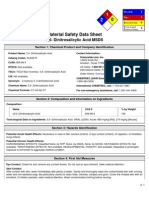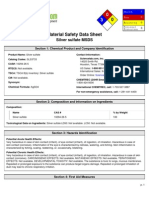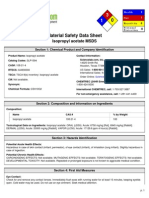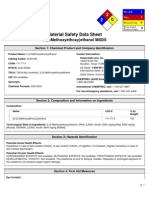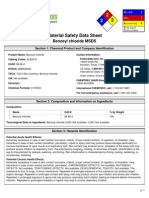Msds
Msds
Uploaded by
Se Won KimCopyright:
Available Formats
Msds
Msds
Uploaded by
Se Won KimOriginal Title
Copyright
Available Formats
Share this document
Did you find this document useful?
Is this content inappropriate?
Copyright:
Available Formats
Msds
Msds
Uploaded by
Se Won KimCopyright:
Available Formats
3 2
Material Safety Data Sheet
Hexamethyl-1,1,1,3,3,3 disilazane MSDS
Section 1: Chemical Product and Company Identification
Product Name: Hexamethyl-1,1,1,3,3,3 disilazane Catalog Codes: SLH3010, SLH1687 CAS#: 999-97-3 RTECS: JM9230000 TSCA: TSCA 8(b) inventory: Hexamethyl-1,1,1,3,3,3 disilazane CI#: Not available. Synonym: Chemical Formula: C6H19NSi2 Contact Information: Sciencelab.com, Inc. 14025 Smith Rd. Houston, Texas 77396 US Sales: 1-800-901-7247 International Sales: 1-281-441-4400 Order Online: ScienceLab.com
He a lt h
2 3 0 H
Fire Re a c t iv it y P e rs o n a l P ro t e c t io n
CHEMTREC (24HR Emergency Telephone), call: 1-800-424-9300 International CHEMTREC, call: 1-703-527-3887 For non-emergency assistance, call: 1-281-441-4400
Section 2: Composition and Information on Ingredients
Composition: Name Hexamethyl-1,1,1,3,3,3 disilazane CAS # 999-97-3 % by Weight 100
Toxicological Data on Ingredients: Hexamethyl-1,1,1,3,3,3 disilazane: ORAL (LD50): Acute: 850 mg/kg [Rat Mouse]. 1100 mg/kg [Rabbit]. DERMAL (LD50): Acute: 543 mg/kg [Rabbit]. VAPOR (LC50): Acute: 8700 ppm 4 hour(s) [Rat].
Section 3: Hazards Identification
Potential Acute Health Effects: Very hazardous in case of ingestion. Hazardous in case of skin contact (irritant), of eye contact (irritant). Slightly hazardous in case of inhalation. Potential Chronic Health Effects: Very hazardous in case of ingestion. Hazardous in case of skin contact (irritant), of eye contact (irritant). Slightly hazardous in case of inhalation. CARCINOGENIC EFFECTS: Not available. MUTAGENIC EFFECTS: Not available. TERATOGENIC EFFECTS: Not available. DEVELOPMENTAL TOXICITY: Not available.
Section 4: First Aid Measures
Eye Contact: Check for and remove any contact lenses. Do not use an eye ointment. Seek medical attention. p. 1
Skin Contact: After contact with skin, wash immediately with plenty of water. Gently and thoroughly wash the contaminated skin with running water and non-abrasive soap. Be particularly careful to clean folds, crevices, creases and groin. Cover the irritated skin with an emollient. If irritation persists, seek medical attention. Wash contaminated clothing before reusing. Serious Skin Contact: Wash with a disinfectant soap and cover the contaminated skin with an anti-bacterial cream. Seek immediate medical attention. Inhalation: Allow the victim to rest in a well ventilated area. Seek immediate medical attention. Serious Inhalation: Evacuate the victim to a safe area as soon as possible. Loosen tight clothing such as a collar, tie, belt or waistband. If breathing is difficult, administer oxygen. If the victim is not breathing, perform mouth-to-mouth resuscitation. Seek medical attention. Ingestion: Do not induce vomiting. Examine the lips and mouth to ascertain whether the tissues are damaged, a possible indication that the toxic material was ingested; the absence of such signs, however, is not conclusive. Loosen tight clothing such as a collar, tie, belt or waistband. If the victim is not breathing, perform mouth-to-mouth resuscitation. Seek immediate medical attention. Serious Ingestion: Not available.
Section 5: Fire and Explosion Data
Flammability of the Product: Flammable. Auto-Ignition Temperature: 380C (716F) Flash Points: CLOSED CUP: 22C (71.6F). Flammable Limits: LOWER: 0.8% Products of Combustion: These products are carbon oxides (CO, CO2), nitrogen oxides (NO, NO2...). Some metallic oxides. Fire Hazards in Presence of Various Substances: Flammable in presence of open flames and sparks. Explosion Hazards in Presence of Various Substances: Risks of explosion of the product in presence of mechanical impact: Not available. Risks of explosion of the product in presence of static discharge: Not available. Fire Fighting Media and Instructions: Flammable liquid. SMALL FIRE: Use DRY chemical powder. LARGE FIRE: Use alcohol foam, water spray or fog. Cool containing vessels with water jet in order to prevent pressure build-up, autoignition or explosion. Special Remarks on Fire Hazards: Not available. Special Remarks on Explosion Hazards: Not available.
Section 6: Accidental Release Measures
Small Spill: Absorb with an inert material and put the spilled material in an appropriate waste disposal. Large Spill: Flammable liquid. Keep away from heat. Keep away from sources of ignition. Stop leak if without risk. Absorb with DRY earth, sand or other non-combustible material. Do not touch spilled material. Prevent entry into sewers, basements or confined areas; dike if needed. Eliminate all ignition sources.
Section 7: Handling and Storage
Precautions: p. 2
Keep away from heat. Keep away from sources of ignition. Ground all equipment containing material. Do not ingest. Do not breathe gas/fumes/ vapour/spray. Wear suitable protective clothing If ingested, seek medical advice immediately and show the container or the label. Avoid contact with skin and eyes Storage: Flammable materials should be stored in a separate safety storage cabinet or room. Keep away from heat. Keep away from sources of ignition. Keep container tightly closed. Keep in a cool, well-ventilated place. Ground all equipment containing material. A refrigerated room would be preferable for materials with a flash point lower than 37.8C (100F).
Section 8: Exposure Controls/Personal Protection
Engineering Controls: Provide exhaust ventilation or other engineering controls to keep the airborne concentrations of vapors below their respective threshold limit value. Ensure that eyewash stations and safety showers are proximal to the work-station location. Personal Protection: Splash goggles. Lab coat. Vapor respirator. Be sure to use an approved/certified respirator or equivalent. Gloves. Personal Protection in Case of a Large Spill: Splash goggles. Full suit. Vapor respirator. Boots. Gloves. A self contained breathing apparatus should be used to avoid inhalation of the product. Suggested protective clothing might not be sufficient; consult a specialist BEFORE handling this product. Exposure Limits: Not available.
Section 9: Physical and Chemical Properties
Physical state and appearance: Liquid. Odor: Not available. Taste: Not available. Molecular Weight: 161.4 g/mole Color: Colorless. pH (1% soln/water): Not available. Boiling Point: 125C (257F) Melting Point: Not available. Critical Temperature: Not available. Specific Gravity: 0.765 (Water = 1) Vapor Pressure: 23 mm of Hg (@ 20C) Vapor Density: 4.6 (Air = 1) Volatility: Not available. Odor Threshold: Not available. Water/Oil Dist. Coeff.: Not available. Ionicity (in Water): Not available. Dispersion Properties: See solubility in water, diethyl ether, acetone. Solubility: Soluble in diethyl ether, acetone.
Section 10: Stability and Reactivity Data
p. 3
Stability: The product is stable. Instability Temperature: Not available. Conditions of Instability: Not available. Incompatibility with various substances: Not available. Corrosivity: Non-corrosive in presence of glass. Special Remarks on Reactivity: Not available. Special Remarks on Corrosivity: Not available. Polymerization: No.
Section 11: Toxicological Information
Routes of Entry: Eye contact. Ingestion. Toxicity to Animals: WARNING: THE LC50 VALUES HEREUNDER ARE ESTIMATED ON THE BASIS OF A 4-HOUR EXPOSURE. Acute oral toxicity (LD50): 850 mg/kg [Rat Mouse]. Acute dermal toxicity (LD50): 543 mg/kg [Rabbit]. Acute toxicity of the vapor (LC50): 8700 ppm 4 hour(s) [Rat]. Chronic Effects on Humans: Not available. Other Toxic Effects on Humans: Very hazardous in case of ingestion. Hazardous in case of skin contact (irritant). Slightly hazardous in case of inhalation. Special Remarks on Toxicity to Animals: Not available. Special Remarks on Chronic Effects on Humans: Not available. Special Remarks on other Toxic Effects on Humans: Not available.
Section 12: Ecological Information
Ecotoxicity: Not available. BOD5 and COD: Not available. Products of Biodegradation: Possibly hazardous short term degradation products are not likely. However, long term degradation products may arise. Toxicity of the Products of Biodegradation: The products of degradation are more toxic. Special Remarks on the Products of Biodegradation: Not available.
Section 13: Disposal Considerations
Waste Disposal:
Section 14: Transport Information
DOT Classification: Class 3: Flammable liquid. Identification: : Flammable liquid, toxic, n.o.s. (Hexamethyldisilazane) : UN1992 PG: II Special Provisions for Transport: Not available.
p. 4
Section 15: Other Regulatory Information
Federal and State Regulations: TSCA 8(b) inventory: Hexamethyl-1,1,1,3,3,3 disilazane Other Regulations: OSHA: Hazardous by definition of Hazard Communication Standard (29 CFR 1910.1200). Other Classifications: WHMIS (Canada): CLASS B-2: Flammable liquid with a flash point lower than 37.8C (100F). CLASS D-1B: Material causing immediate and serious toxic effects (TOXIC). DSCL (EEC): R10- Flammable. R21/22- Harmful in contact with skin and if swallowed. R36/38- Irritating to eyes and skin. HMIS (U.S.A.): Health Hazard: 2 Fire Hazard: 3 Reactivity: 0 Personal Protection: h National Fire Protection Association (U.S.A.): Health: 2 Flammability: 3 Reactivity: 0 Specific hazard: Protective Equipment: Gloves. Lab coat. Vapor respirator. Be sure to use an approved/certified respirator or equivalent. Wear appropriate respirator when ventilation is inadequate. Splash goggles.
Section 16: Other Information
References: Not available. Other Special Considerations: Not available. Created: 10/09/2005 05:43 PM Last Updated: 11/01/2010 12:00 PM The information above is believed to be accurate and represents the best information currently available to us. However, we make no warranty of merchantability or any other warranty, express or implied, with respect to such information, and we assume no liability resulting from its use. Users should make their own investigations to determine the suitability of the information for their particular purposes. In no event shall ScienceLab.com be liable for any claims, losses, or damages of any third party or for lost profits or any special, indirect, incidental, consequential or exemplary damages, howsoever arising, even if ScienceLab.com has been advised of the possibility of such damages.
p. 5
You might also like
- The Health & Safety Guide for Film, TV & Theater, Second EditionFrom EverandThe Health & Safety Guide for Film, TV & Theater, Second EditionRating: 4 out of 5 stars4/5 (1)
- Qri and Literacy Assessment PaperDocument13 pagesQri and Literacy Assessment Paperapi-384084766No ratings yet
- NEMA MG1 Motors and GeneratorsDocument709 pagesNEMA MG1 Motors and Generatorslam266100% (3)
- Mineral Spirits - MsdsDocument5 pagesMineral Spirits - MsdsKen StewartNo ratings yet
- Pyrolle MsdsDocument5 pagesPyrolle MsdsAmalina HazwaniNo ratings yet
- Acetophenon PDFDocument6 pagesAcetophenon PDFYuris Yurdiansah Munandar0% (1)
- Acetophenone PDFDocument6 pagesAcetophenone PDFYuliana Ja'farNo ratings yet
- Msds Diaseton AlkoholDocument5 pagesMsds Diaseton AlkoholtakenoveraccountNo ratings yet
- MSDS 2,3,5 CollidineDocument5 pagesMSDS 2,3,5 CollidineSiddhant ChhabraNo ratings yet
- Msds OctaneDocument5 pagesMsds Octanenirmal_subudhiNo ratings yet
- Msds DNSADocument5 pagesMsds DNSAfontianikaNo ratings yet
- Malachite GreenDocument5 pagesMalachite GreenChern YuanNo ratings yet
- Cinna Mal de HideDocument5 pagesCinna Mal de Hiderully1234No ratings yet
- 2 NaftolDocument5 pages2 Naftolhide999No ratings yet
- Eugenol MSDS: Section 1: Chemical Product and Company IdentificationDocument5 pagesEugenol MSDS: Section 1: Chemical Product and Company IdentificationLaraz ShawolmvpNo ratings yet
- Material Safety Data Sheet: Tert-Amyl Alcohol MSDSDocument6 pagesMaterial Safety Data Sheet: Tert-Amyl Alcohol MSDSmicaziv4786No ratings yet
- Msds Eugenol PDFDocument5 pagesMsds Eugenol PDFIchlas MuttaqinNo ratings yet
- MSDS - Isoamil AlkoholDocument6 pagesMSDS - Isoamil AlkoholAyu MurtiNo ratings yet
- Thiamine HCL MSDS: Section 1: Chemical Product and Company IdentificationDocument5 pagesThiamine HCL MSDS: Section 1: Chemical Product and Company IdentificationAurora Buitrago RuízNo ratings yet
- Chromic Acetate MSDS: Section 1: Chemical Product and Company IdentificationDocument5 pagesChromic Acetate MSDS: Section 1: Chemical Product and Company IdentificationErika WidiariniNo ratings yet
- Msds TioureaDocument5 pagesMsds TioureaNurul HidayatiNo ratings yet
- Anhidrida Asetat Msds PDFDocument6 pagesAnhidrida Asetat Msds PDFFistia MaulinaNo ratings yet
- Sodium PersulfateDocument5 pagesSodium PersulfateRanjit BeraNo ratings yet
- Ag SO4Document5 pagesAg SO4ptnamhoangNo ratings yet
- Msds Acetyl ChlorideDocument6 pagesMsds Acetyl ChlorideghungrudswapnilNo ratings yet
- Diethylene GlycolDocument5 pagesDiethylene Glycolsatnam1979No ratings yet
- Msds Titipan1Document5 pagesMsds Titipan1anitacahyaNo ratings yet
- EthanolDocument5 pagesEthanolGery Job'sNo ratings yet
- Potassium Perch Lo Rate MsdsDocument5 pagesPotassium Perch Lo Rate MsdsPavan KumarNo ratings yet
- Cuprous Oxide MSDS: Section 1: Chemical Product and Company IdentificationDocument5 pagesCuprous Oxide MSDS: Section 1: Chemical Product and Company IdentificationAbdurrohman RangkutiNo ratings yet
- Amonium OksalatDocument5 pagesAmonium OksalatIkhwan DarmabaktiNo ratings yet
- Msds HexanaDocument5 pagesMsds HexanaGilang RamadhanNo ratings yet
- Msds Isopropil EterDocument5 pagesMsds Isopropil EterLidwina Margaretha LakaNo ratings yet
- BoraksDocument5 pagesBoraksyayax_619No ratings yet
- Atropine Ld50Document5 pagesAtropine Ld50valertronNo ratings yet
- Ammonium OxalateDocument5 pagesAmmonium Oxalatedhanaraj39No ratings yet
- Msds EterDocument5 pagesMsds EterMuhammad Edi SukmanaNo ratings yet
- Isopentane MsdsDocument5 pagesIsopentane Msdslqiroxita100% (1)
- Urea MsdsDocument5 pagesUrea MsdsRea Candra OktaviaraNo ratings yet
- Sodium Chromate TetrahydrateDocument6 pagesSodium Chromate TetrahydrateErika WidiariniNo ratings yet
- Msds Fumaric AcidDocument5 pagesMsds Fumaric AcidManas Xabat NigamNo ratings yet
- Msds 1Document5 pagesMsds 1Dick Ferieno FirdausNo ratings yet
- Msds Butyl AcetateDocument6 pagesMsds Butyl AcetateArsalan Ahmad KhanNo ratings yet
- 1 1 - Dichloroethane MSDSDocument6 pages1 1 - Dichloroethane MSDSAndi Tri SaputraNo ratings yet
- Msds NitobenzeneDocument5 pagesMsds NitobenzeneAnngie Nove SimbolonNo ratings yet
- Bismuth Nitrate MSDS: Section 1: Chemical Product and Company IdentificationDocument5 pagesBismuth Nitrate MSDS: Section 1: Chemical Product and Company IdentificationIne Ciptanisah PratiwiNo ratings yet
- ButilacetatDocument6 pagesButilacetatmicaziv4786No ratings yet
- Msds SilverDocument5 pagesMsds SilverSteppenwolf2012No ratings yet
- Sodium Acetate MsdsDocument5 pagesSodium Acetate MsdsMehmet Besim SacilikNo ratings yet
- Acetic Anhydride MSDS: Section 1: Chemical Product and Company IdentificationDocument6 pagesAcetic Anhydride MSDS: Section 1: Chemical Product and Company IdentificationAdri MuntahaNo ratings yet
- Msds Ac2oDocument6 pagesMsds Ac2oArfin FardiansyahNo ratings yet
- KCLO3Document6 pagesKCLO3Raditya Rizki AmaliaNo ratings yet
- Msds K2cro4 PDFDocument6 pagesMsds K2cro4 PDFAnonymous U0RczPNo ratings yet
- Benzaldehyde MSDS: Section 1: Chemical Product and Company IdentificationDocument5 pagesBenzaldehyde MSDS: Section 1: Chemical Product and Company Identificationmariyana kusumawatiNo ratings yet
- Msds C7H5OClDocument6 pagesMsds C7H5OClwindawardhaniNo ratings yet
- Legally Poisoned: How the Law Puts Us at Risk from ToxicantsFrom EverandLegally Poisoned: How the Law Puts Us at Risk from ToxicantsNo ratings yet
- A Consumerýs Dictionary of Household, Yard and Office Chemicals: Complete Information About Harmful and Desirable Chemicals Found in Everyday Home Products, Yard Poisons, and Office PollutersFrom EverandA Consumerýs Dictionary of Household, Yard and Office Chemicals: Complete Information About Harmful and Desirable Chemicals Found in Everyday Home Products, Yard Poisons, and Office PollutersNo ratings yet
- First Aid on the Farm: Natural and Conventional TreatmentsFrom EverandFirst Aid on the Farm: Natural and Conventional TreatmentsNo ratings yet
- Go Toxic Free: Easy and Sustainable Ways to Reduce Chemical PollutionFrom EverandGo Toxic Free: Easy and Sustainable Ways to Reduce Chemical PollutionNo ratings yet
- After a Disaster - Information to Help You and Your Family RecoverFrom EverandAfter a Disaster - Information to Help You and Your Family RecoverNo ratings yet
- CSS GSA 2018 Solved PaperDocument20 pagesCSS GSA 2018 Solved PaperKhuleedShaikhNo ratings yet
- Module 3 Learning Targets For Performance and ProductOriented AssessmentDocument20 pagesModule 3 Learning Targets For Performance and ProductOriented AssessmentPaul PaguiaNo ratings yet
- Proposal Writing GuidelineDocument5 pagesProposal Writing Guidelineyididiya gezahegneNo ratings yet
- Importance of Patient Experience and Efforts To Improve It: 2022123268 Seoyeon Park Business AdministrationDocument2 pagesImportance of Patient Experience and Efforts To Improve It: 2022123268 Seoyeon Park Business Administrationparkseoyeon623No ratings yet
- Fis Feb KeyDocument13 pagesFis Feb KeyYanqing YangNo ratings yet
- Article AssgnmentDocument27 pagesArticle AssgnmentNurul NadiaNo ratings yet
- Grade10 QP Mathematics 2Document12 pagesGrade10 QP Mathematics 2Bhavya SrivastavaNo ratings yet
- Data Inter & SufficencyDocument98 pagesData Inter & SufficencyTanya HughesNo ratings yet
- ECE4762007 Lect12Document42 pagesECE4762007 Lect12Salvador JovenNo ratings yet
- Managing Windows Server 2003 and Active Directory Best PracticesDocument35 pagesManaging Windows Server 2003 and Active Directory Best Practicesculymn78No ratings yet
- Well Stimulation TechniquesDocument165 pagesWell Stimulation TechniquesRafael MorenoNo ratings yet
- Draft Conference 2024 Write Up & ProgrammeDocument4 pagesDraft Conference 2024 Write Up & ProgrammeShamil FitriNo ratings yet
- Oil Gas SapDocument4 pagesOil Gas SapSachin Karekar0% (1)
- Elect DistributionDocument66 pagesElect DistributionmanojdaspallaNo ratings yet
- Prestige WaterfordDocument62 pagesPrestige Waterfordpmenocha8799No ratings yet
- Programmers GuideDocument314 pagesProgrammers GuideDaniel e Joana CabralNo ratings yet
- Action Verbs For ThesisDocument6 pagesAction Verbs For Thesisbk25ghr2100% (2)
- SPESIFIKASI PC LAPTOP For Autodesk Inventor 2019Document2 pagesSPESIFIKASI PC LAPTOP For Autodesk Inventor 2019nasirNo ratings yet
- SAMPLE Mastercam X9 Instructor Guides MetricDocument19 pagesSAMPLE Mastercam X9 Instructor Guides Metricprem_mechenggNo ratings yet
- 3-A Accepted Practices For A Method of Producing Culinary Steam, Number 609-03Document8 pages3-A Accepted Practices For A Method of Producing Culinary Steam, Number 609-03CHRISTIAN ZAVALANo ratings yet
- Help SPM Cefr Listening ModuleDocument7 pagesHelp SPM Cefr Listening ModuleCjleeNo ratings yet
- 03 - Assignment # Elasticity - EngDocument11 pages03 - Assignment # Elasticity - Engpihukri69No ratings yet
- Thermal AnalysisDocument3 pagesThermal AnalysisMathew JohnNo ratings yet
- 1st Experiment PDFDocument115 pages1st Experiment PDFlakshmiNo ratings yet
- MS400ADocument2 pagesMS400AMariyappanSubhash100% (1)
- Disaster ManagementDocument24 pagesDisaster ManagementRaj KumarNo ratings yet
- Harmony in NumbersDocument2 pagesHarmony in NumbersBayoyoy NaragasNo ratings yet
- DDB Ch27Document60 pagesDDB Ch27mohamedelgohary679No ratings yet










